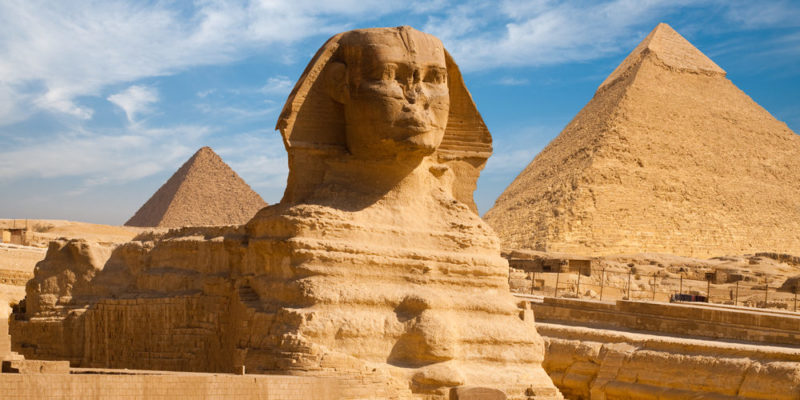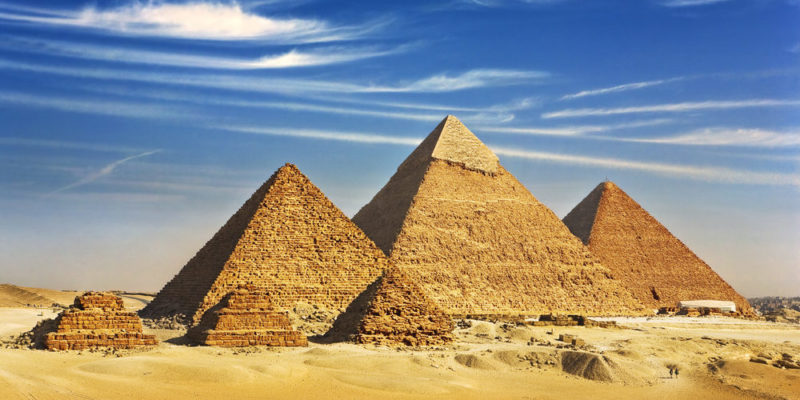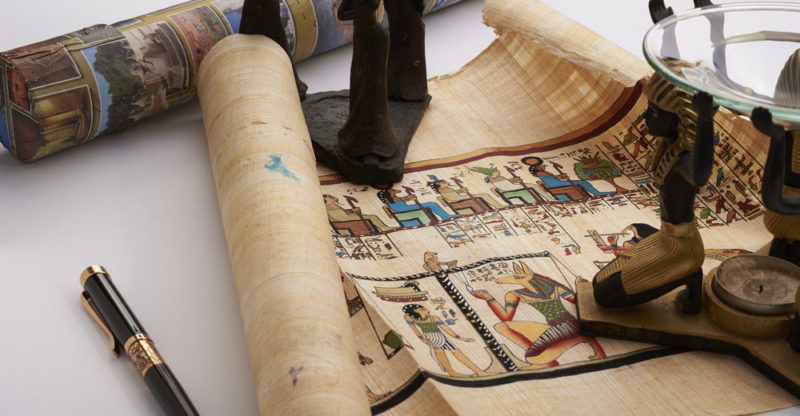We explain what the Egyptian civilization was and what its religion and architecture was like. In addition, its characteristics, discoveries and medicine.
What is the Egyptian civilization?
 The Egyptian civilization was formed around 4,000 BC after the rise of writing , and was the most iconic and powerful civilization in history .
The Egyptian civilization was formed around 4,000 BC after the rise of writing , and was the most iconic and powerful civilization in history .It was established on the banks of the Nile River in the north of the African continent , which, with its annual floods, allowed to supply irrigation to the sown fields, which is why agriculture became the main source of wealth in the region.
The Egyptian civilization reached a great development in science , art , religion and commerce . It was noted for the majesty of its monuments covered in hieroglyphics carved on its walls (which are the main sources of information for archaeologists).
Origin of Egyptian civilization
 Egyptian civilization settled in the northeast of the African continent , bordered to the east by the Red Sea and to the north by the Mediterranean Sea . The Egyptians called this land Kemet, which meant " black and fertile land ", which was surrounded by vast sandy deserts (the present territories of Sudan, Israel, and Libya).
Egyptian civilization settled in the northeast of the African continent , bordered to the east by the Red Sea and to the north by the Mediterranean Sea . The Egyptians called this land Kemet, which meant " black and fertile land ", which was surrounded by vast sandy deserts (the present territories of Sudan, Israel, and Libya).In its beginnings, before becoming the powerful civilization, ancient Egypt was divided into two kingdoms around the Fertile Crescent (or Fertile Crescent) region made up of Red Earth to the north and White Earth to the south. A century later, King Menes would dominate the north and unify the region, becoming the first king of the dynasty of Egyptian pharaohs.
Political organization of Egyptian civilization
Egyptian society was made up of a descending hierarchy of the gods , the king, the blessed dead, and humanity (the people). The government was under the command of the king or pharaoh who, for the ancient Egyptians, was a divine being who acted as a link between humans and the gods, and was the protector of the people.The pharaohs were human figures appointed by the gods themselves. The thrones were hereditary and lasted throughout the life of the pharaoh, who had absolute power, even over religion.
Egyptian religion
 The Egyptians practiced the type of polytheistic religion, that is, they venerated various gods whom they identified with different phenomena of nature (such as wind, thunder, fertility, among others). The most important god was "Amun Ra", god of the sun , followed by "Osiris", god of the dead.
The Egyptians practiced the type of polytheistic religion, that is, they venerated various gods whom they identified with different phenomena of nature (such as wind, thunder, fertility, among others). The most important god was "Amun Ra", god of the sun , followed by "Osiris", god of the dead.The ancient Egyptians believed that the soul, called "ka", was immortal and could not exist without its body . That is why they performed important rituals and prepared the remains for death, from the construction of tombs, mummification and funeral ceremonies with the delivery of offerings, in order to protect the body and soul for the future life.
The Egyptians regarded music as a science and, as such, required study . It was used in various activities, especially in temples to accompany rituals. The hieroglyph that represented this art is the same one that alluded to the word well-being .
During the 18th Egyptian dynasty, Pharaoh Akhenaten established major reforms in religion , making it a monotheist to worship a single sun god, Aten. However, the orientation of the buildings did not maintain any solar or cosmic pattern, it only adapted to the topography of the terrain.
The religious revolution caused by Akhenaten and his new religious abstraction, among other new measures, unleashed a great problem in the Egyptian belief system , because the people could not conceive of their gods without a tangible form or image.
Architecture of Egyptian civilization
 The main icons of Egyptian architecture are the pyramids . They consist of majestic stone constructions that functioned as tombs and that allow the soul to undertake its journey to another life. They had a complex system of corridors and chambers, where they finally located the mummified body along with numerous belongings, food, drink and valuables that could be useful to the soul in another life.
The main icons of Egyptian architecture are the pyramids . They consist of majestic stone constructions that functioned as tombs and that allow the soul to undertake its journey to another life. They had a complex system of corridors and chambers, where they finally located the mummified body along with numerous belongings, food, drink and valuables that could be useful to the soul in another life.Due to their advanced knowledge in mathematics and measurements, the Egyptians handled numbers and calculations like no other civilization . They created a form of measurement called "Elbow" that was calculated by measuring the length of the forearm (from the elbow to the fingertips). Later they developed the calculation in "Royal Elbow" which was equivalent to 0.524 meters in length and was subdivided into 7 sections of 4 fingers each (with a total of 28 fingers per unit of measurement).
The Great Pyramid of Giza was ordered to be built by Pharaoh Khufu around 2570 BC, and its base measures 440 cubits x 440 cubits (equivalent to 230.56 meters x 230.56 meters). It is estimated that its construction lasted 20 years and that it required the work of about 10,000 men. It is currently the oldest of the seven wonders of the world.
Most of the pyramids have been looted throughout history , due to the amount of valuables they contained. However, archaeologists have been able to learn amazing details thanks to the hieroglyphic writings that abound on the walls of these temples.
Discoveries of Egyptian civilization
 Among the main discoveries of the Egyptian civilization, the following stand out:
Among the main discoveries of the Egyptian civilization, the following stand out:
- The Egyptian calendar: Due to advanced knowledge in mathematics and astronomy , they established a 24-hour division of the day and created a calendar, first lunar, and later it was adapted to a solar calendar that consisted of 365 days in a year, a period that began with the Nile river flood. They calculated the month and the season of the year, represented by symbols.
- The writing system: The Egyptians took the concept of writing from the Sumerians and created their own pictographic method using hieroglyphs (system based on drawings and symbols). Mainly thanks to writing, archaeologists can learn about the customs, beliefs, stories and characteristics of civilization.
- The plow drawn by animals: The peasants of the Nile Valley used a fire- hardened wooden plow to till the land. Later, they adapted the cart so that it could be pulled by oxen that were whipped with a whip to advance.
- The copper mirror: It was a flattened object made entirely of polished copper that was very expensive to manufacture, so it was reserved for the nobility. It consisted of a shiny surface that reflected fairly sharp images, thus allowing the pharaohs to put on makeup or adjust their crown.
- The papyrus: It consisted of a flexible sheet obtained from the stems of the "Papyrus" plant, which reached up to 4 meters in height and was abundant in northern Egypt. The sheets were cut into pieces to make documents or posters on which they wrote and drew.
Egyptian medicine
 The religious beliefs about death and resurrection , coupled with the knowledge of anatomy and chemistry, made civilization stand out in the field of health.
The religious beliefs about death and resurrection , coupled with the knowledge of anatomy and chemistry, made civilization stand out in the field of health.They believed that diseases were sent as punishment by the gods or that they were evil spirits that were in the body and had to be expelled through rituals or spells.
Due to the tradition of mummifying, they developed skills to know the different parts of the body and associate them with certain diseases. They have even performed surgeries, of which traces were found in some mummies (such as skull perforations or tumor removal). In this way, they were able to identify up to 28 different types of injuries.
She has pursued her studies in The United States, where she has graduated in Business and Economics and is currently finishing her Master studies in International Economics and Finance. Miss. Amputee is fluent in three languages: English, Spanish and Russian and has elementary knowledge of French and Italian. She love exploring how Collaborative Research Group can become the best tool to achieve the (necessary) educational change. .
Leave a reply
Your email address will not be published. Required fields are marked *Recent post

Sport: What Is It, Types, Risks, Features, Characteristics and Examples
September 23, 2021

Dogs: Emergence, Features, Characteristics, Feeding and Breeds
September 24, 2021

Story: Definition, Elements, Structure, Features and Characteristics
September 24, 2021

Essay: Definition, Structure, Features, Characteristics, How to Do It
September 24, 2021
